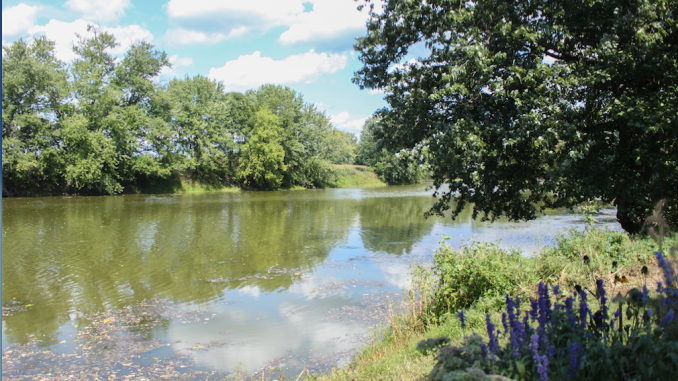
The Wallkill River has turned bright green due to a toxic algae bloom. Samples were taken from the river by Riverkeeper and Wallkill River Watershed Alliance over the past several weeks and analysis through a Department of Energy Conservation (DEC) screening program has revealed toxins up to 25 times greater than the DEC’s “High Toxin” threshold.
In a statement released jointly by leaders of the two organizations on Aug. 25, the public was advised that, “The algae bloom was visible from bank to bank in the vicinity of New Paltz,” including Sojourner Truth Park and at the Carmine Liberta (Route 299) Bridge reconstruction site.
It has been visible as far upstream as Gardiner and as far downstream as Rifton. Other public-access locations within this section include the Village of New Paltz boat launch on Springtown Road, the Wallkill River Valley Rail Trail bridge crossing, the DEC boat launch in Town of Rosendale, Perrine’s Bridge Park in Town of Esopus and several informal access sites used by anglers.
The algae are part of the genus Microcystis, which causes illness primarily when ingested. It is one of three genera of freshwater cyanobacteria that are being tracked widely as sources of harmful algae blooms. Illness can range from skin irritation to serious neurological damage, although that is rare in humans.
According to Riverkeeper Jennifer Epstein, people are advised to steer clear of the river and wash themselves and their equipment as quickly as possible should they come into contact with the algae.
“DEC cautions that people should avoid water that appears green, regardless of whether potentially toxic species have been identified, or toxins have been confirmed,” she said.
In areas with powerboats, the toxins can become aerosolized and be inhaled, but the primary danger is to humans and other mammals who swim in the water. For example, dogs tend to lick their fur as they dry and some have been killed due to these toxins.
According to biologist and Wallkill River Watershed Alliance volunteer Jillian Decker, there are three factors that cause algal blooms such as the one in Wallkill.
“I like to call it the perfect storm,” she said.
The algae is not invasive, its growth is encouraged by changes in the river. Those changes include high water temperatures, slow or stagnant water and excess nutrients.
According to biologist and Wallkill River Watershed Alliance volunteer John Gotto, the primary nutrients in excess are nitrogen and phosphorus and there are many sources from which these can come.
“Up and down the river there are probably hundreds of sources of excess nutrients, from everybody who fertilizes their lawn to municipalities who have inadequate sewage treatment facilities that periodically overflown,” he said.
The Alliance plans to advocate for better riparian buffers to screen out these excess nutrients.
The green color caused by the algae should be fading soon, but unfortunately that does not mean the end of the problems with this bloom. As the algae die off and begin to decompose, the process consumes oxygen vital to the wildlife in the river.
“It’s possible that we will see fish kill as a result of oxygen depletion,” said Epstein. “Short of die-offs, the low oxygen conditions could be stressful for aquatic organisms.”
Members of Riverkeeper and Wallkill River Watershed Alliance encourage community members to become more aware of the environment and take individual steps to prevent climate change, the likely cause of the river’s rising temperatures.
“We have a long-term goal of helping that river be restored to its natural health,” Gotto said. “We would like to see it as a desirable recreational resource, something that people are drawn to, not something people are afraid of.”
Anybody who is interested in working toward this goal is welcome to volunteer with either organization. Director of Wallkill River Watershed Alliance Jason West encourages anyone who wants to get involved to contact his organization at wallkillalliance@gmail.com or to visit their website wallkillalliance.org or their Facebook page.
